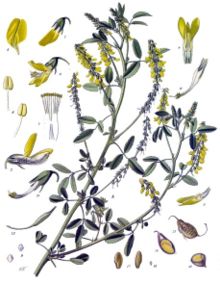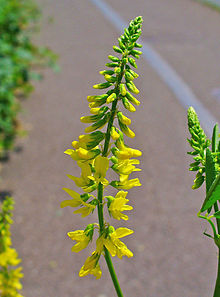- Melilotus officinalis
-
Melilotus officinalis 
Scientific classification Kingdom: Plantae (unranked): Angiosperms (unranked): Eudicots (unranked): Rosids Order: Fabales Family: Fabaceae Subfamily: Faboideae Tribe: Trifolieae Genus: Melilotus Species: M. officinalis Binomial name Melilotus officinalis
(L.) Pall.Melilotus officinalis, known as the yellow sweet clover, yellow melilot, ribbed melilot or common melilot is a species of legume native to Eurasia and introduced in North America, Africa and Australia.
Contents
Description
This biennial plant is 2 to 4 feet high at maturity and blooms in spring and summer. Flowers are yellow. Its characteristic sweet odor, intensified by drying, is derived from coumarin. It has a bitter taste.
Ecology
This plant is very common as it can adapt itself to various soils (but especially likes alkaline soils) and climates. It is resistant to drought and has abundant seed production. In some areas it is an invasive species. Common places where it can be found include prairies, abandoned fields, roadsides, and railroad ballasts. It does not tolerate dense shade.
Toxicology
Sweet clover contains coumarin that converts to dicoumarol (a powerful anticoagulant toxin) when the plant becomes moldy. This can lead to bleeding diseases (internal hemorrhaging) and death in cattle. Consequently, hay containing the plant must be properly dried and cured, especially in wet environments.[1]
Uses
This plant is mainly used for agricultural purposes. It is grown as hay despite its toxic properties when moldy. It is considered an excellent green manure. Also, sweet clover is a major source of nectar for domestic honey bees. Flowers and seeds can be used as flavoring.[citation needed]
In the chemical industry, dicoumarol is extracted from the plant to produce rodenticides.[citation needed]
References
- ^ Nicole Kresge, Robert D. Simoni, and Robert L. Hill. "Hemorrhagic Sweet Clover Disease, Dicumarol, and Warfarin: the Work of Karl Paul Link". http://www.jbc.org/cgi/content/full/jbc;280/8/e5. Retrieved 2009-08-11.
External links
Categories:- Faboideae
- Flora of Europe
- Flora of Estonia
- Flora of the United Kingdom
- Medicinal plants
- Honey plants
Wikimedia Foundation. 2010.

